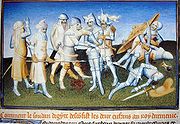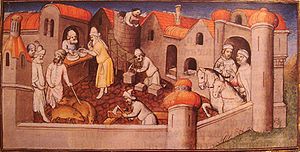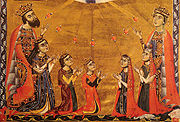
Leo III of Armenia
Encyclopedia
Leo II or Leon II was king of the Armenian Kingdom of Cilicia
, ruling from 1269/1270 to 1289. He was the son of King Hetoum I and Queen Isabella and was a member of the Hetoumid family.
 Leo was born in 1236, the son of King Hetoum I and Queen Isabella. Hetoum and Isabella's marriage in 1226 had been a forced one by Hetoum's father Constantine of Baberon
Leo was born in 1236, the son of King Hetoum I and Queen Isabella. Hetoum and Isabella's marriage in 1226 had been a forced one by Hetoum's father Constantine of Baberon
, who had arranged for Queen Isabella's first husband to be murdered so as to put Constantine's own son Hetoum in place as a co-ruler with Isabella. They had six children, of which Leo was the eldest. One of his sisters was Sibylla of Armenia
, who was married to Bohemond VI of Antioch to bring peace between Armenia and Antioch.
In 1262 Leo married Keran
(Kir Anna), the daughter of Prince Hetoum of Lampron
.
In 1266, while their father king Hetoum I was away to visit the Mongol court, Leo and his younger brother Thoros fought to repel Mamluk
invaders, at the Battle of Mari
. Thoros was killed in combat, and Leo, along with 40,000 other Armenian soldiers was captured and imprisoned. When King Hetoum returned, he paid a large ransom to retrieve his son, including a large quantity of money, handing over several fortresses, and accepting to intercede with the Mongol ruler Abagha in order to have one of Baibars
's relatives freed.
 Hetoum I abdicated in 1269 in favour of his son, and entered the Franciscan order. He died a year later. The new king Leo II was known as a pious king, devoted to Christianity
Hetoum I abdicated in 1269 in favour of his son, and entered the Franciscan order. He died a year later. The new king Leo II was known as a pious king, devoted to Christianity
. He pursued active commercial relations with the West, by renewing trade agreements with the Italians and establishing new ones with the Catalans. He also endeavoured to reinforce the Mongol alliance, as his father Hetoum I had submitted Armenia to Mongol authority in 1247.
In 1271, Marco Polo
visited the Armenian harbour of Ayas
and commented favourably about Leo's reign and the abundance of the country, although he mentions his military forces were rather demoralized:
 In 1275 the Mamluk sultan Baibars
In 1275 the Mamluk sultan Baibars
invaded Cilicia for a second time. The following year, Armenia fought off an invasion by the Turkomans
, but the Constable Sempad
, Leo's uncle, was killed in combat.
. Leo had to sue for peace, and in 1285 obtained a 10-year truce in exchange for important territorial concessions in favour of the Mamluks.
Leo died in 1289, and was succeeded by his son Hetoum II.
 During twenty-one years of marriage Leo had sixteen children by his wife Keran
During twenty-one years of marriage Leo had sixteen children by his wife Keran
, ten sons and six daughters. Three sons and three daughters died at an early age. Five of his children reached the throne. The eldest, Hetoum II of Armenia, abdicated after four years in favor of his younger brother Thoros III of Armenia
, but was placed back on the throne in 1294. In 1296, their brother Sempad of Armenia
strangled Thoros and blinded Hetoum, in order to seize power. Sempad was then overthrown in 1298 by their younger brother Constantine III of Armenia
, who was replaced by older brother Hetoum, who then abdicated in 1305 in favor of Thoros's son Leo III of Armenia
.
Of the sixteen children, only ten made it to adulthood and five of them, Hethum, Thoros, Sempad, Constantine and Oshin, would later become Armenian Kings. They often fought each other to keep or gain the throne, but it were the descendants of their sister Isabella
that finally inherited the throne.
Armenian Kingdom of Cilicia
The Armenian Kingdom of Cilicia , also known as the Cilician Armenia, Kingdom of Cilician Armenia or New Armenia, was an independent principality formed during the High Middle Ages by Armenian refugees fleeing the Seljuk invasion of Armenia...
, ruling from 1269/1270 to 1289. He was the son of King Hetoum I and Queen Isabella and was a member of the Hetoumid family.
Early life

Constantine of Baberon
Constantine of Baberon was a powerful Armenian noble of the Hetoumids family. He was the son of Vassag, the maternal uncle of king Levon I of Armenia...
, who had arranged for Queen Isabella's first husband to be murdered so as to put Constantine's own son Hetoum in place as a co-ruler with Isabella. They had six children, of which Leo was the eldest. One of his sisters was Sibylla of Armenia
Sibylla of Armenia
Sibylla of Armenia was the daughter of Queen Isabella of Armenia and king Hethoum I of Armenia and was a member of the Hetoumid family....
, who was married to Bohemond VI of Antioch to bring peace between Armenia and Antioch.
In 1262 Leo married Keran
Queen Keran of Armenia
Keran was the wife of Leo II of Armenia. She was the daughter of Prince Hethum of Lampron. Born Anna, she was called Kir Anna beginning in 1270. This name was later shortened to Keran, or Guerane....
(Kir Anna), the daughter of Prince Hetoum of Lampron
Lampron
Lampron - is a castle near the town of Çamlıyayla in Mersin Province, Turkey. While part of the Armenian Kingdom of Cilicia in the Middle Ages, the castle was known as Lampron and was the ancestral home of the Armenian Hethumid princes...
.
In 1266, while their father king Hetoum I was away to visit the Mongol court, Leo and his younger brother Thoros fought to repel Mamluk
Mamluk
A Mamluk was a soldier of slave origin, who were predominantly Cumans/Kipchaks The "mamluk phenomenon", as David Ayalon dubbed the creation of the specific warrior...
invaders, at the Battle of Mari
Battle of Mari
The Battle of Mari, also called the Disaster of Mari, was a battle between the Mamluks of Egypt and the Armenians of Cilician Armenia on August 24, 1266....
. Thoros was killed in combat, and Leo, along with 40,000 other Armenian soldiers was captured and imprisoned. When King Hetoum returned, he paid a large ransom to retrieve his son, including a large quantity of money, handing over several fortresses, and accepting to intercede with the Mongol ruler Abagha in order to have one of Baibars
Baibars
Baibars or Baybars , nicknamed Abu l-Futuh , was a Mamluk Sultan of Egypt. He was one of the commanders of the forces which inflicted a devastating defeat on the Seventh Crusade of King Louis IX of France and he led the vanguard of the Egyptian army at the Battle of Ain Jalut in 1260, which marked...
's relatives freed.
Reign

Christianity
Christianity is a monotheistic religion based on the life and teachings of Jesus as presented in canonical gospels and other New Testament writings...
. He pursued active commercial relations with the West, by renewing trade agreements with the Italians and establishing new ones with the Catalans. He also endeavoured to reinforce the Mongol alliance, as his father Hetoum I had submitted Armenia to Mongol authority in 1247.
In 1271, Marco Polo
Marco Polo
Marco Polo was a Venetian merchant traveler from the Venetian Republic whose travels are recorded in Il Milione, a book which did much to introduce Europeans to Central Asia and China. He learned about trading whilst his father and uncle, Niccolò and Maffeo, travelled through Asia and apparently...
visited the Armenian harbour of Ayas
Ayas (city)
Ayas is a small town in Yumurtalık district, Adana Province, Turkey, located east of the mouth of the Ceyhan River. It was the ancient Aegea and medieval Ajazzo or Lajazzo. It passed between the Mamluks and the Armenians several times in the 13th and 14th centuries, and was definitively taken by...
and commented favourably about Leo's reign and the abundance of the country, although he mentions his military forces were rather demoralized:

Baibars
Baibars or Baybars , nicknamed Abu l-Futuh , was a Mamluk Sultan of Egypt. He was one of the commanders of the forces which inflicted a devastating defeat on the Seventh Crusade of King Louis IX of France and he led the vanguard of the Egyptian army at the Battle of Ain Jalut in 1260, which marked...
invaded Cilicia for a second time. The following year, Armenia fought off an invasion by the Turkomans
Turkmen people
The Turkmen are a Turkic people located primarily in the Central Asian states of Turkmenistan, Afghanistan, and northeastern Iran. They speak the Turkmen language, which is classified as a part of the Western Oghuz branch of the Turkic languages family together with Turkish, Azerbaijani, Qashqai,...
, but the Constable Sempad
Sempad the Constable
Sempad the Constable was a noble in Cilician Armenia, an older brother of King Hetoum I. He was an important figure in Cilicia, acting as a diplomat, judge, and military officer, holding the title of Constable or Sparapet, supreme commander of the Armenian armed forces...
, Leo's uncle, was killed in combat.
Mongol alliance
In 1281 Leo joined the Mongols in their invasion of Syria, but they were vanquished at the Second Battle of HomsSecond Battle of Homs
The Second Battle of Homs was fought in western Syria on October 29, 1281, between the armies of the Mamluk dynasty of Egypt and Ilkhanate, division of the Mongol Empire centered on Iran...
. Leo had to sue for peace, and in 1285 obtained a 10-year truce in exchange for important territorial concessions in favour of the Mamluks.
Leo died in 1289, and was succeeded by his son Hetoum II.
Descendance

Queen Keran of Armenia
Keran was the wife of Leo II of Armenia. She was the daughter of Prince Hethum of Lampron. Born Anna, she was called Kir Anna beginning in 1270. This name was later shortened to Keran, or Guerane....
, ten sons and six daughters. Three sons and three daughters died at an early age. Five of his children reached the throne. The eldest, Hetoum II of Armenia, abdicated after four years in favor of his younger brother Thoros III of Armenia
Thoros III of Armenia
Thoros III or Toros III was king of the Armenian Kingdom of Cilicia, ruling from 1293 to 1298. He was the son of Leo II of Armenia and Kyranna de Lampron, and was part of the Hethumid dynasty. In 1293 his brother Hethum II abdicated in his favour; however, Thoros recalled Hethum to the throne in...
, but was placed back on the throne in 1294. In 1296, their brother Sempad of Armenia
Sempad of Armenia
Sempad, Smpad, Sambat, or Smbat ; 1277 – c. 1310) was king of the Armenian Kingdom of Cilicia, ruling from 1296 to 1298. He was the son of Leo II of Armenia and Kyranna de Lampron and was part of the Hetoumid-family....
strangled Thoros and blinded Hetoum, in order to seize power. Sempad was then overthrown in 1298 by their younger brother Constantine III of Armenia
Constantine III of Armenia
Constantine I was briefly king of the Armenian Kingdom of Cilicia from 1298 to 1299...
, who was replaced by older brother Hetoum, who then abdicated in 1305 in favor of Thoros's son Leo III of Armenia
Leo III of Armenia
Leo II or Leon II was king of the Armenian Kingdom of Cilicia, ruling from 1269/1270 to 1289. He was the son of King Hetoum I and Queen Isabella and was a member of the Hetoumid family.-Early life:Leo was born in 1236, the son of King Hetoum I and Queen Isabella...
.
- Son (b. 15 January 1262/14 January 1263 – d. young).
- Constantine (b. June 1265 – d. young).
- Fimi [Euphemia] (b. 14 January 1266/13 January 1267 – d. young).
- Hethum II (b. 14 January 1266/13 January 1267 – murdered 7 November 1307), King of Armenia (ruled 1289 to 1293, 1294 to 1297, 1299 to 1307).
- Isabella [Zabel] (b. 13 January 1269/12 January 1270 – d. bef. 1273).
- Thoros III (b. October 1270 – murdered 23 July 1298), King of Armenia (ruled 1293 to 1298).
- Ruben (b. 13 January 1272/12 January 1273 – d. young)
- Isabella [Zabel] (b. 12 January 1273/11 January 1274 – d. bef. 1276).
- Sempad (b. 12 January 1276/11 January 1277 – d. 1310 or 1311), King of Armenia (ruled 1297 to 1299).
- Isabella (b. 12 January 1276/11 January 1277 – murdered May 1323), twin with Sempad; married in 1293 with Amalric of Lusignan, Prince of TyreAmalric, Prince of TyreAmalric de Lusignan or Amaury II de Lusignan, Prince of Tyre , of the Lusignan family, was a son of Hugh III of Cyprus and Isabella of Ibelin.-Biography:...
, son of King Hugh III of CyprusHugh III of CyprusHugh III of Cyprus , born Hughues de Poitiers, later Hughues de Lusignan , called the Great, was the King of Cyprus from 1267 and King of Jerusalem from 1268 . He was the son of Henry of Antioch and Isabella of Cyprus, the daughter of Hugh I...
. - Constantine I (b. 11 January 1277/10 January 1278 – d. aft. 1308), King of Armenia (ruled 1299).
- RitaRita of ArmeniaRita of Armenia was a daughter of King Levon II of Armenia and Queen Keran. She was the wife of Byzantine co-emperor Michael IX Palaiologos, making her a junior empress-consort of the Byzantine Empire. In 1317, she became the only empress upon the death of the senior empress, Irene of Montferrat...
(b. 11 January 1278/10 January 1279 – July 1333), renamed Maria upon her wedding; married in 1294 with Michael IX Palaeologus, co-Emperor of the Byzantine EmpireByzantine EmpireThe Byzantine Empire was the Eastern Roman Empire during the periods of Late Antiquity and the Middle Ages, centred on the capital of Constantinople. Known simply as the Roman Empire or Romania to its inhabitants and neighbours, the Empire was the direct continuation of the Ancient Roman State...
with his father Andronicus II Palaeologus. - Theophanu (b. 11 January 1278/10 January 1279 – d. 1296), renamed Teodora upon her betrothal; she died in route to married Theodore, son of John I DoukasJohn I DoukasJohn I Doukas was ruler of Thessaly from c. 1268 to his death in 1289....
, Lord of Thessaly. - Nerses (b. 11 January 1279/10 Jan 1280 – d. 26 May 1301), a priest.
- Oshin (b. 10 January 1283/9 January 1284 – murdered 20 July 1320), King of Armenia (ruled 1308 to 1320).
- Alinakh (b. 10 January 1283/9 January 1284] – d. 28 August 1310), twin with Oshin; Lord of LampronLampronLampron - is a castle near the town of Çamlıyayla in Mersin Province, Turkey. While part of the Armenian Kingdom of Cilicia in the Middle Ages, the castle was known as Lampron and was the ancestral home of the Armenian Hethumid princes...
and TarsusTarsus, MersinTarsus is a historic city in south-central Turkey, 20 km inland from the Mediterranean Sea. It is part of the Adana-Mersin Metropolitan Area, the fourth-largest metropolitan area in Turkey with a population of 2.75 million...
.
Of the sixteen children, only ten made it to adulthood and five of them, Hethum, Thoros, Sempad, Constantine and Oshin, would later become Armenian Kings. They often fought each other to keep or gain the throne, but it were the descendants of their sister Isabella
Princess Isabella of Armenia
Princess Isabella, Isabelle or Zabel of Armenia was the daughter of Leo II of Armenia. Originally she was promised in marriage to the King Andrew II of Hungary when he was returning home from the Fifth Crusade, but the wedding plan was eventually abandoned.She was married at Nicosia in 1292/1293...
that finally inherited the throne.

